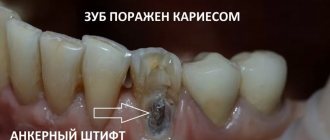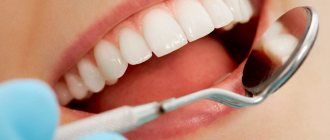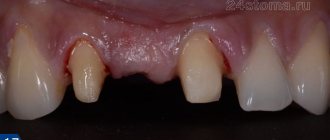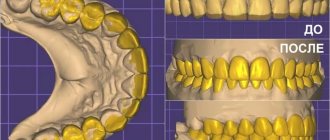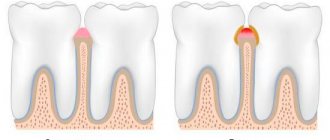Preparing teeth for prosthetics begins with an examination by an orthopedic dentist. It determines the scope and list of measures that will be required to effectively restore the integrity of the dentition.
The basis of preparation is accurate diagnosis. The condition of both jaws can be assessed using a panoramic X-ray - orthopantomogram. It allows:
- see the condition of all teeth;
- assess the condition, volume, structure of the bone tissue of the jaws;
- identify diseases that may interfere with prosthetics (periodontitis, root cysts, etc.);
- determine the condition of soft tissues, the depth of periodontal pockets with periodontal disease, etc.
Based on the diagnostic results, the doctor determines what preparation measures will be required.
Therapeutic preparation
Therapeutic preparation is necessary for the purpose of sanitation of the oral cavity. First of all, professional teeth cleaning is carried out:
- removal of hard dental deposits using ultrasound, less often - mechanical cleaning;
- removing soft plaque using the Air Flow method;
- polishing, fluoridation (remineralizing therapy).
Preparing teeth for prosthetics includes mandatory removal of foci of infection and inflammation. Treatment of caries and complications in the form of pulpitis, periodontitis is carried out, and therapy for inflammatory diseases of the gums and soft tissues of the oral cavity (periodontitis, gingivitis, glossitis, etc.) is prescribed.
Therapeutic preparation also includes removal of the pulp of teeth to be replaced. Afterwards, endodontic treatment is carried out - treatment and filling of the root canals.
Who's on the benefits list?
The social security department at your place of residence will tell you which prosthetics are free for pensioners. The procedure for providing free services is regulated by federal law, regardless of place of residence. The Federal Law “On State Social Assistance” contains a main list of those who have grounds for receiving free services at the expense of the state budget. Help is provided free of charge
:
- war participants;
- heroes of the Soviet Union;
- victims of Stalinist repressions;
- labor veterans.
Free prosthetics for pensioners in certain regions of the Russian Federation has its own characteristics and is regulated by regional laws.
Next for free services
in prosthetics can apply for:
- disabled people of groups 1 and 2;
- beneficiaries who were in line for preferential prosthetics up to January 1, 2005 inclusive;
- disabled people of the accident at the Chernobyl nuclear power plant;
- pensioners after working in government agencies and law enforcement agencies;
- old age pensioners with a certificate of no additional income.
Taking into account the number of quotas, citizens from the first federal list always have advantages.
Additional benefits may be approved in each individual region. For example, dental prosthetics for pensioners in Moscow with benefits
and
a reduced price
is possible for the following citizens:
- home front workers;
- honorary donors;
- mothers of many children who gave birth and raised 5 or more children;
- non-working pensioners.
The quota distribution is given according to the waiting list. The right of first priority is given to those who are included in the general federal list, regardless of the region. Depending on the membership of one or another category of beneficiaries, the package of documents may change. The complete list must be verified at your place of residence.
Surgical preparation
Surgical preparation involves the removal of teeth that cannot be treated. For example, highly mobile ones, having a large root cyst, granulating periodontitis, etc.
Osteophytes and exostoses, if present, are also removed. They are outgrowths of bone tissue and can interfere with the installation of a denture.
Surgical preparation of teeth for prosthetics may also include removal of excess soft tissue due to hypertrophy of the mucous membranes and gums.
Implant placement also refers to surgical preparation. Osteoplastic surgery, the implantation of artificial or natural bone tissue to achieve the required volume of bone in the jaw, can also be used as a preliminary stage. One of the types of such an operation is a sinus lift, raising the bottom of the maxillary sinus.
Required documents
To get in line, you need to contact the social protection department at your place of residence or the local administration with the results of the survey. There you will be given an application form to fill out. Copies of the following documents are attached to the application
:
- medical opinion on the need to install dental prostheses;
- copy of passport;
- pension or other certificate;
- medical insurance (CHI);
- SNILS.
The list may be expanded depending on the preferential category.
If a pensioner cannot come himself for health reasons, a guardian or a social worker will do this for him if there is a guardianship agreement. The entire list of documents will be provided by the social security authorities in your area.
Orthopedic training
Orthopedic preparation involves attention to secondary tooth deformations after removal of those located nearby or “antagonist” (located on the opposite jaw) teeth. It involves creating special plates and trays to move protruding teeth to create space for dentures on the opposite jaw. It may also be necessary to make special trays to relieve the masticatory muscles. This is necessary for bruxism and increased muscle tone to prevent damage to structures.
Preparing teeth for prosthetics is a whole range of measures that are designed to prevent the difficulties of wearing artificial structures and are necessary to ensure oral health.
Why is it necessary to depulp teeth under metal-ceramics?
This question is very often asked by patients at the stage of preparation for metal-ceramic prosthetics . The name of this design makes it clear that it is based on metal, on top of which ceramic coating is applied, after which the prosthesis is fired in a special oven - this procedure ensures the strength of the connection between metal and ceramics. In order to ensure that after installation of the prosthesis it does not overestimate the bite and does not cause discomfort, it is necessary to create space; for this purpose, the supports are pre-prepared, removing the required amount of enamel and dentin. Thus, the layer of tissue protecting the pulp becomes much thinner. This often leads to so-called postoperative pain, increased sensitivity and the possible development of traumatic pulpitis, since the nervous tissue is highly sensitive. If, some time after installing the prosthesis, the tooth under the crown suddenly begins to hurt and become inflamed, then the entire structure will have to be removed, the resulting inflammation treated , and starting all over again.
Date of publication: September 20, 2020 Last update: September 22, 2022 © 2020 Professorial Dentistry “22 Century”. All rights reserved.
Prosthetics on implants
Preparatory work includes all necessary procedures. After this, in a two-stage protocol, they wait for the implants to take root, then make impressions and make dentures according to the general scheme.
With a one-stage protocol, the installation of temporary structures is provided immediately after implantation. After about a year, permanent dentures are made and installed. Prices for implant prosthetics may be higher, but the designs last longer and are more reliable, which makes the cost not as high as it seems at first glance.
At the ROOTT ICDC in Moscow, they carry out the entire range of preparatory measures for prosthetics. Our own laboratory, therapeutic, surgical, and orthopedic departments guarantee coordinated work of doctors and excellent results.
Expert of the article Alekperov Roman Borisovich Dentist-orthopedist, doctor of the first category
Work experience 24 years.
Crowns
Crowns are placed:
- on pulpless teeth to protect them from destruction;
- to units destroyed by more than 50%
; - on teeth in which only the root is preserved;
- with abnormal abrasion of enamel;
- for aesthetic defects, the correction of which is impossible by other means;
- for implants.
After all the preparatory manipulations, the doctor grinds the tooth down to the thickness of the future crown. If the tooth is completely destroyed, a pin is inserted into the root. Then the tooth stump is prepared. It is given a shape that will allow you to put the crown on top and ensure its stability.
After this, impressions of the teeth are taken, always of both jaws, to ensure good occlusion (touch) of the teeth. Based on the impressions, crowns will be made in the laboratory, which the doctor will adjust so that they fit tightly on the supporting tooth.
During the fitting, the orthopedist checks the correctness of the bite, contact with adjacent teeth, and how comfortable the patient is with the crown. For the first few days, it is recommended to wear the crown with temporary cement to get used to it. Then, if necessary, another adjustment is made and the crown is secured with permanent cement.
When installing a crown on an implant, both cement and screw fixation are used.
Restoring the aesthetics of the dentition
In our clinic, special attention is paid to measures aimed exclusively at restoring a beautiful smile, when a person stops stressing because of his dental problems, he becomes more confident, his life often changes for the better - unnecessary complexes disappear due to bad teeth and stale breathing, obstacles that previously caused serious problems with communication are eliminated, the patient is fully socialized, and his quality of life noticeably improves.
Qualified restoration of the dentition not only returns lost opportunities to the patient, but also prevents further disruption of the chewing system, the condition of the oral cavity, stops and reverses the deterioration of the appearance of the face, which is especially important for women of any age.
Preparation for removable prosthetics
After the preparatory work, the orthopedic surgeon determines the type of product, method of fixation, and supporting teeth.
It can be:
- Complete removable dentures. Plate products are made from acrylic, nylon or new polymers such as AcryFree
- Partially removable dentures. There are lamellar, clasp, adhesive, immediate (temporary)
The doctor makes impressions of the teeth, from which plaster or wax models are made in the laboratory, on the basis of which a prosthesis is made. When using clasp prosthetics, a metal arch is cast from selected materials - a clasp, and a base and crowns are placed on it. The orthopedist performs fitting and correction, after which the patient is given time to get used to it. After that, another correction is possible and a rehabilitation period begins. Its duration is different for each patient.
Warranty
The service for preferential dental prosthetics for pensioners provides for the conclusion of an agreement between social security authorities and a medical institution for warranty service. Contract duration – 6-12 months
. If the work done by the doctor fails due to a medical error, the clinic is obliged to replace or repair it at its own expense. The cause of the damage is determined by a special commission.
If you follow your dentist’s recommendations correctly, undergo regular preventive examinations, and carefully care for your dentures, your dentures will last from 3 to 10 years.
depending on the type.
Orthodontic stage
Treatment is aimed at correcting malocclusion and occlusion (contact between the teeth of the upper and lower jaw). Teeth are moved using braces, aligners and plates. This is done not only to correct the bite, but also to correct the position of the supporting teeth and create a place for attaching dentures.
